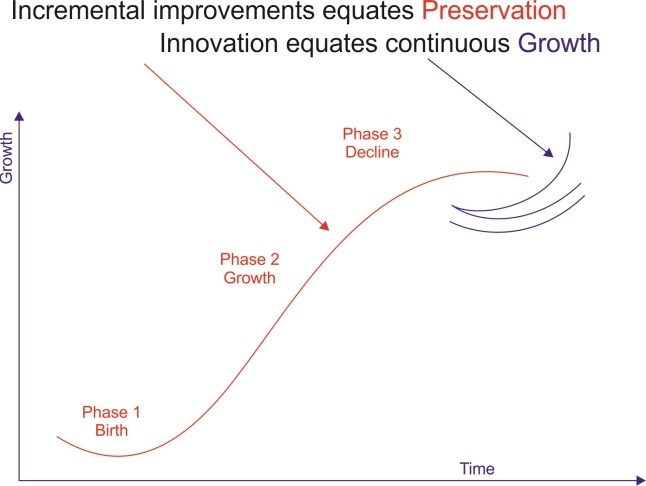
Innovation in a nutshell
* Innovation is not a discovery, because discoveries are unexpected findings that get published.
* Innovation is not necessarily an invention, because an invention is an action of inventing something that usually gets patented, and is not necessarily commercially viable.
* Innovation is a commercially viable new product or service.
Innovation = idea + supplier value + user value
Although this definition is only one of many, I love its simplicity.
I do, however, have a further characteristic to add before claiming a true blue innovation, namely that the innovation offering should not just be an incremental improvement in doing the same thing better - it should be a significant jump in doing it differently.
Innovation is not only doing something better, it is also about doing it differently.
This concept implies jumping from the current S-curve to a new S-curve to ensure future delivery of the required function, therefore not only moving up a notch on the same S-curve. A typical example of such an S-curve jump is the cellphone that disrupted the traditional analogue phone and fax machine market by jumping to digital technology to transmit voice communication and photo images over long distances.
Innovation skills can be taught
During my school years, I was taught that someone is born either creative or not creative.
During 2005, I was introduced to TRIZ, which is a Russian acronym for: "The Theory of Inventive Problem Solving", where Genrich Altshuller countered this belief with his view that creativity can be developed by teaching people to solve problems inventively in a structured manner.
Accepting that innovation is a viable commercial outcome of an inventive solution to a problem or a need, which people can be taught to solve in a structured manner, companies and institutions can now extend their survival in a fast-changing world.
Although companies and institutions per se cannot create inventive solutions to changing demands, the company or institution can have their employees trained and skilled with the right kind of knowledge and tools to do so.

Such training will be based on structured methodologies and will give access to specific bodies of knowledge that have become globally available to innovators.
These methodologies and knowledge will enable employees to inter alia identify and resolve technical contradictions and business conflicts, understand the eight 'evolution patterns', the 35 'technology evolution trends', and the 42 'business evolution trends'. Also how to facilitate innovation initiatives effectively and efficiently, to ensure future growth for the company or institution.
The capacity to originate has become the most sought after talent of our time.
Value of innovation initiatives
All products and services offered by companies or institutions have a limited life, being days or decades, which can be assessed on an S-curve. It is therefore imperative that companies and institutions must do these assessments in time to find inventive solutions that will meet future demands and needs before it's too late. And this is precisely what many global organisations are investing in today, to reposition and transform in time to satisfy future markets.
How to enable viable innovation initiatives
Companies or institutions that have not yet started a training and development programme to upskill the people that are accountable to ensure the long-term growth of the company or institution, should consider such an investment before they reach a point of no-return.

To innovate, people need access to specific knowledge, skills in structured methodologies, and tools. Sustainable innovation is not "flashes of ingenious insight" - it is hard work.
A good strategy for a lift-off is to contract an external advisory service that has experienced consultants in innovation methodologies and tools to identify, train and coach the right people in applying the different methodologies and tools, to ensure viable innovation initiatives.
Ensure such advisors can answer fundamental questions like:
* What is your definition of innovation?
* What structured innovation methodologies can you offer?
* What innovation tools will you be able to train our people to use?
* Where should our innovation focus be?
* How can we determine the level of innovation that will ensure our future growth?
* Will you commit to specific deliverables within defined cost and time limit?
The answers should be verifiable on the Internet, in professional publications, or at acknowledged institutions.
Be careful with answers that sell "first create a culture for innovation" and "develop a passion for innovation", which are viewpoints that will develop after successful innovation initiatives.
Share